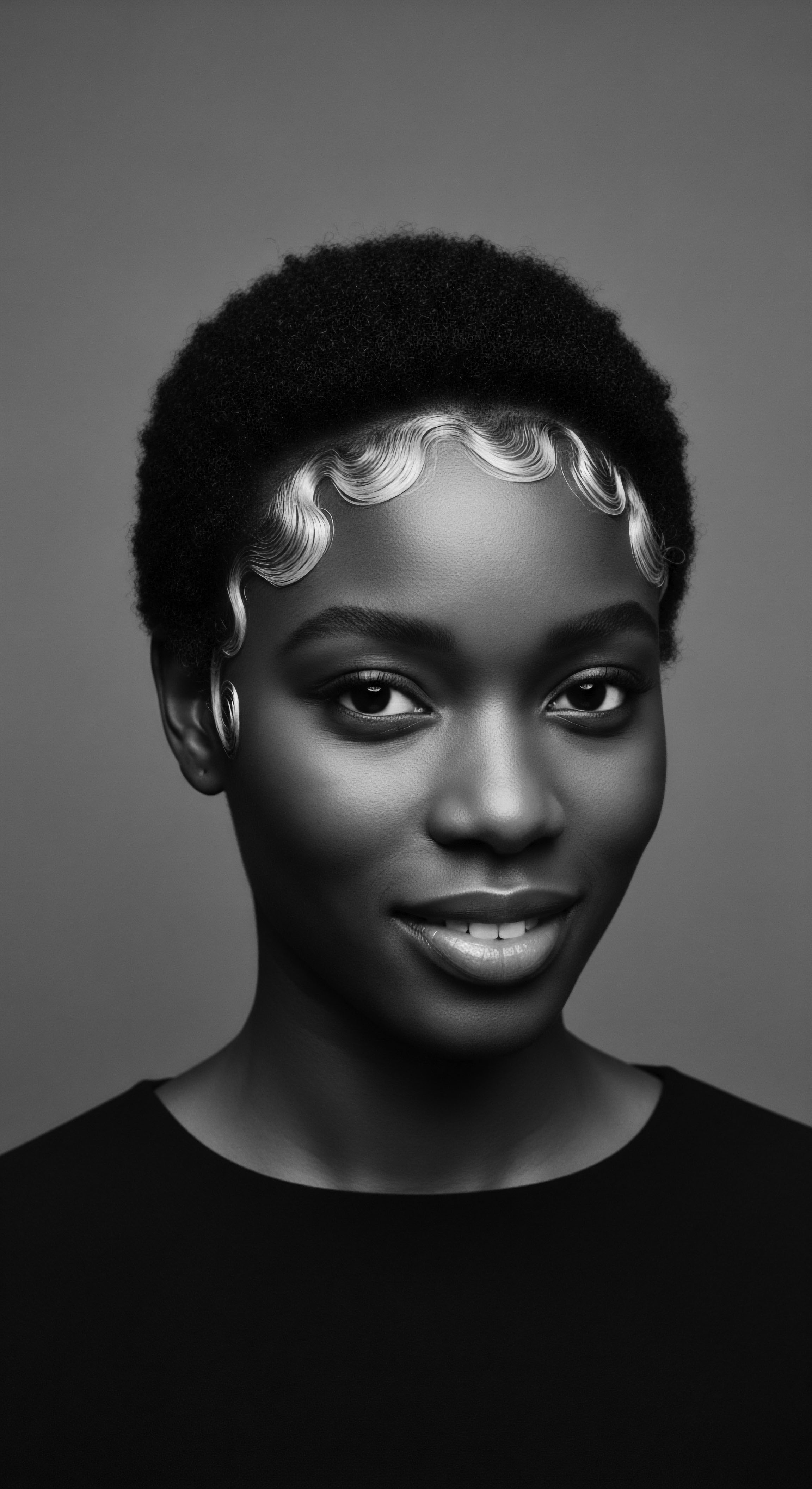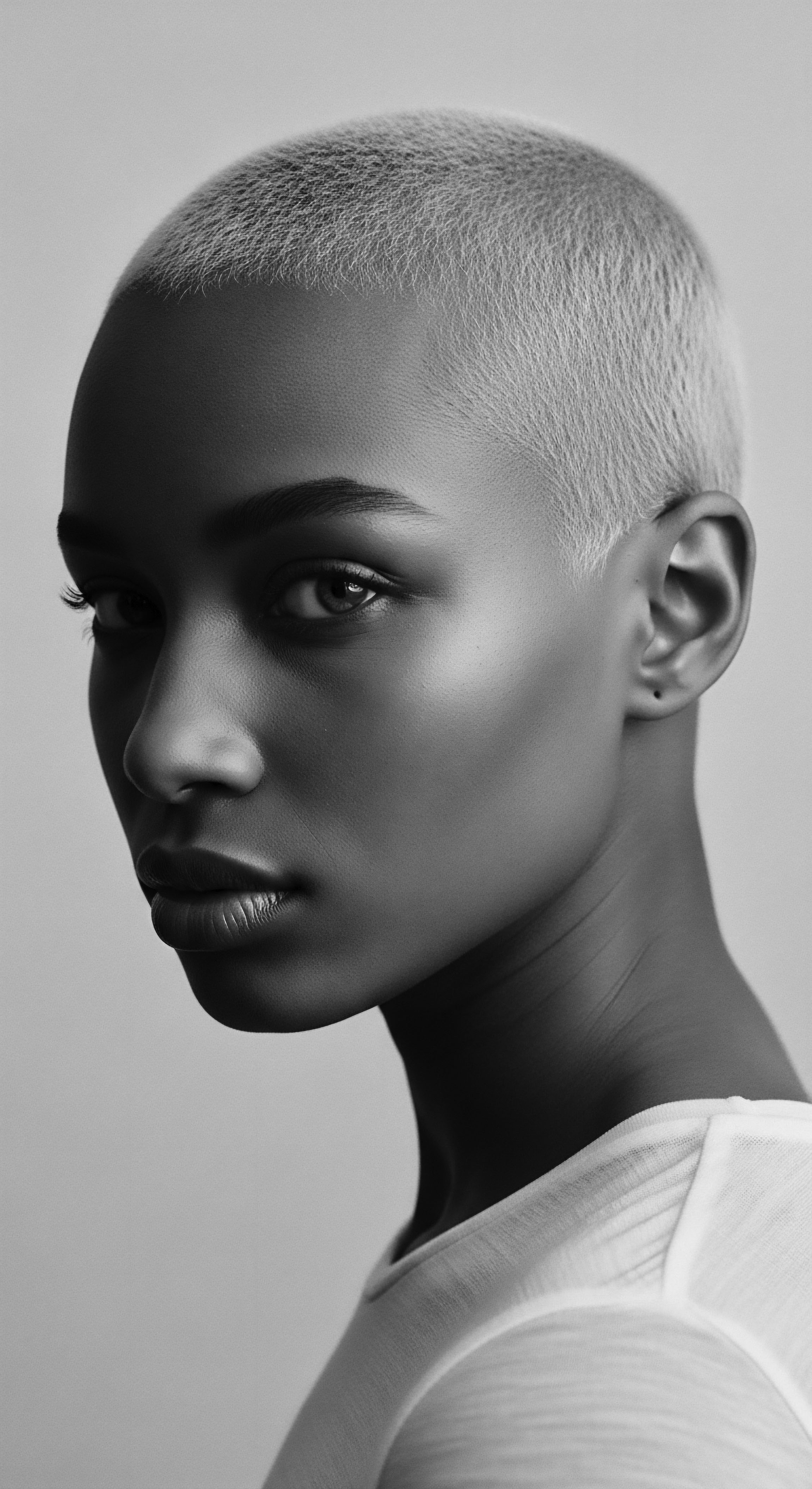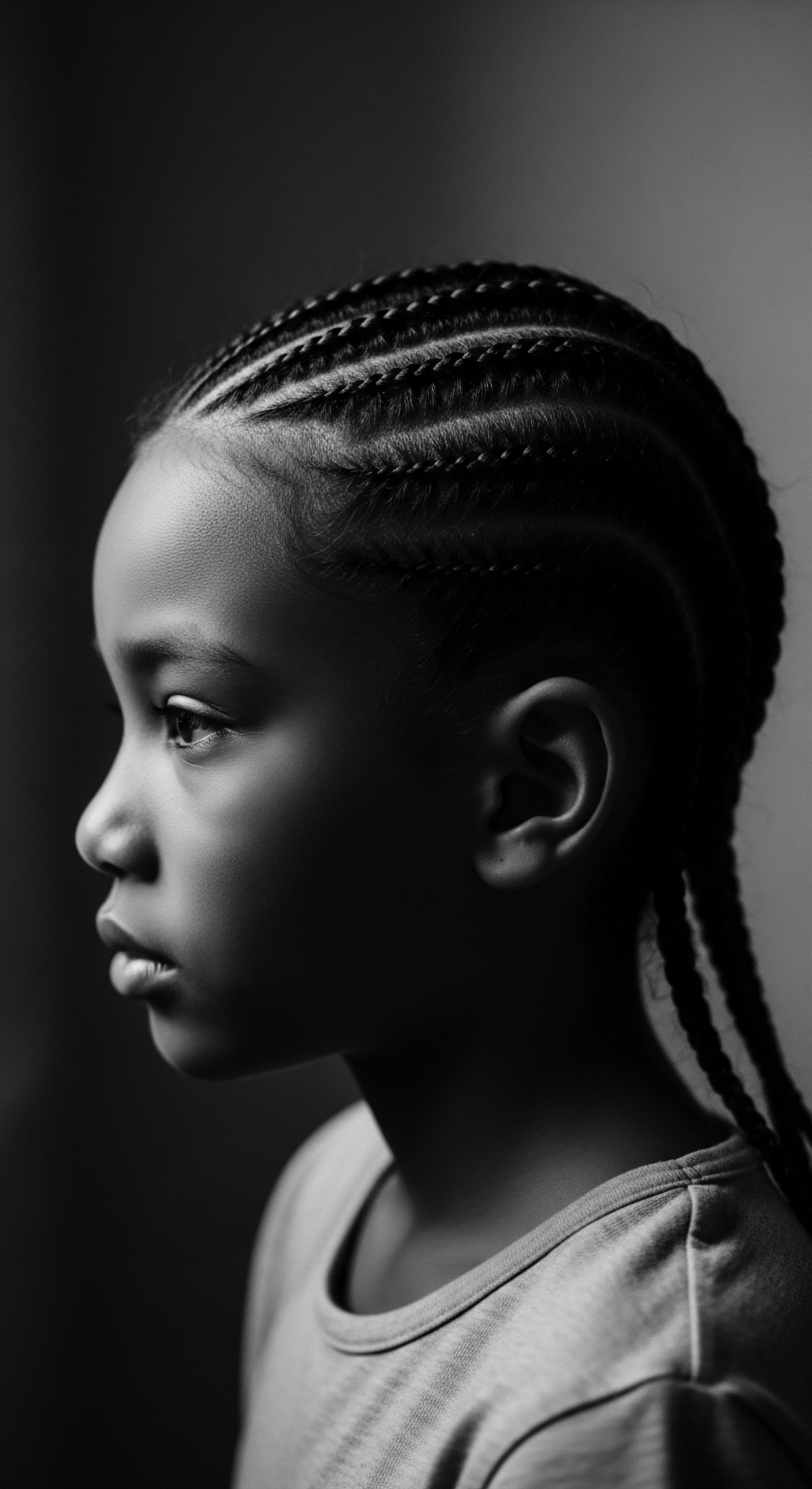
Roots
For those of us whose hair tells stories of intricate spirals, resilient coils, and waves that dance with ancestral memory, the journey of understanding its very nature often begins not in a contemporary salon, but in the echoes of distant times. Our textured hair, a vibrant testament to heritage, carries within its very structure the whispers of countless generations. It is a living archive, and in seeking its profound care, one might naturally turn to the origins of human ingenuity in grooming. And so, we turn our gaze to the sun-drenched banks of the Nile, to the ancient Egyptians, a civilization whose wisdom, in myriad ways, still guides our contemporary inquiries into well-being.
Can the practices observed in the Nile Valley, thousands of years removed, truly offer fresh perspectives on holistic wellness for our textured hair today? Absolutely. Their approach, deeply rooted in a reverence for the body as a temple and appearances as reflections of inner state, held principles that resonate with what we now understand as holistic well-being.
They saw hair not merely as a surface adornment but as an extension of one’s vitality, a medium for spiritual connection, and a canvas for societal identity. This ancient understanding, often overlooked in the broad sweep of history, holds keys to unlocking a deeper appreciation for the intrinsic value and needs of coils and kinks that have long been misunderstood or marginalized in modern beauty narratives.

Hair Anatomy And Ancient Reverence
The core of textured hair’s distinct character lies within its unique anatomical make-up. Unlike straight strands, which typically possess a round cross-section, coiled and curly hair exhibits an elliptical or even flattened shape. This structural difference, observed at the microscopic level today, creates specific points where the strand naturally bends and twists, forming curls. It is at these bends that the cuticle, the protective outer layer of the hair, can be raised, allowing moisture to escape more readily and making the hair more prone to dryness and tangles.
The ancient Egyptians, without the benefit of microscopes, certainly understood the visual and tactile differences of various hair types present within their diverse population. Their meticulous attention to hair care, preserved through funerary artifacts, papyri, and wall paintings, speaks to a sophisticated, observational understanding of hair’s needs. They recognized that some hair types required more lubrication, more gentle handling, and more deliberate styling to retain their health and luster.
This was not a scientific analysis in our modern sense, but an intuitive, practical knowledge born of consistent observation and inherited wisdom. The very act of applying rich oils and balms to the scalp and strands was a direct response to a need for moisture retention and cuticle smoothing, a testament to their keen perception of hair’s behavior.
Ancient Egyptian hair practices, born of astute observation and handed-down wisdom, provide a foundational understanding for the unique requirements of textured hair today.

Early Hair Classifications And Cultural Significance
While the Egyptians did not use terms like “Type 4C” or “3B,” their varied hairstyles and wig constructions suggest an awareness of differing hair textures and how best to manipulate them. Evidence points to the presence of various hair types within ancient Egyptian society, reflecting its diverse ethnic composition, including indigenous African populations with tightly coiled hair, as well as those with wavier or looser curl patterns. The elaborate coiffures depicted on pharaohs, queens, and common people alike demonstrate a mastery of styling that could only arise from a profound understanding of hair’s inherent properties. For instance, the tight, intricate braids seen on many depictions of royals required specific handling and maintenance, quite distinct from the simpler, straighter styles of some Mesopotamian neighbors.
Consider the wig-making industry that flourished. These wigs, often made from human hair, plant fibers, or even wool, were not merely fashionable; they served practical purposes, offering protection from the sun, providing hygiene, and signifying social status. The very process of preparing and styling these wigs, often replicating natural hair patterns, required an intrinsic knowledge of how different fibers and hair textures behaved, how they could be twisted, braided, or smoothed to achieve desired effects. This speaks to a practical classification system, perhaps unspoken, but lived and applied daily.
What specific cultural aspects underpinned their hair care? The Egyptians believed hair was linked to a person’s life force and spiritual purity. The meticulous ritual of cleansing, oiling, and styling hair was often a daily practice, especially for the elite, often involving specialized attendants. This elevated status of hair care within their daily routines suggests that maintaining healthy, vibrant hair was not a mere vanity, but a component of holistic self-care and an act of devotion to one’s physical and spiritual well-being.
- Kohl and Oil Blends ❉ Used for both cosmetic and medicinal purposes, these preparations often contained ingredients like castor oil and moringa oil, beneficial for hair sheen and scalp health.
- Head Cones ❉ Often depicted in banquets, these perfumed wax cones would melt, releasing fragrant oils that conditioned hair and skin, indicating an ancestral practice of continuous, leave-in treatment.
- Clay and Henna ❉ Used for cleansing, coloring, and strengthening the hair, these natural compounds show a reliance on earthly materials for hair fortification and aesthetic transformation.

Ritual
The artistry of ancient Egyptian hair practices was not a superficial pursuit. It was a deeply embedded ritual, a daily act of self-connection and cultural expression that held profound meaning for their structured society. These ancestral rhythms of care, steeped in intention and natural materials, mirror the enduring quest for wellness within textured hair communities today. The methodologies they employed, from intricate braiding to the careful application of botanical elixirs, offer a profound historical counterpoint to contemporary concerns around preserving the integrity and vitality of our coils and curls.

Were Ancient Egyptian Hair Practices Foundational For Protective Styling?
Many of the elaborate hairstyles seen in ancient Egyptian art, particularly on individuals with hair textures that would naturally coil or tightly curl, were indeed early forms of protective styling. Consider the countless depictions of braided or twisted coiffures. These styles, often meticulously constructed and adorned, would have offered significant protection to the hair shaft from environmental aggressors like sun and dust, and reduced daily manipulation.
Such practices align remarkably with modern protective styles such as braids, twists, and locs, which minimize breakage, retain length, and safeguard delicate strands. The underlying principle is identical ❉ to create a shield for the hair, allowing it to rest and grow.
Archaeological findings, such as the discovery of mummified remains with intact hairstyles, confirm the intricate nature and longevity of these styles. The hair on these remains often shows signs of being tightly braided or woven, sometimes with extensions, which speaks to a sophisticated understanding of how to preserve hair over extended periods. This continuous practice of securing and preserving hair speaks to a profound respect for the hair’s vulnerability and its capacity for growth when cared for with deliberation. It also reflects a communal practice, where such elaborate styles likely required the assistance of others, fostering bonds of shared ritual and care.

Natural Styling Techniques and Ancient Elixirs
The Egyptians were masters of enhancing hair’s natural qualities. Their use of plant-based oils and fats, such as castor oil , moringa oil , and almond oil , was not random; these were chosen for their emollient properties, their capacity to add sheen, and their ability to keep hair supple. These natural emollients would have been applied generously to the scalp and strands, providing the much-needed lubrication that textured hair often requires to maintain flexibility and prevent breakage.
The practice of oiling, a cornerstone of ancient Egyptian hair care, directly mirrors the “LOC” (Liquid-Oil-Cream) method or similar moisturizing regimens common in textured hair communities today. They understood the necessity of sealing in moisture, a critical step for hair types prone to dryness.
Their concoctions, often infused with aromatic resins and plant extracts like frankincense and myrrh , served a dual purpose ❉ cosmetic enhancement and therapeutic benefit. These ingredients possess anti-inflammatory and antimicrobial properties, suggesting that ancient Egyptians sought not just outward beauty, but also scalp health—a vital, often overlooked aspect of holistic hair wellness. This holistic viewpoint, where internal health and external radiance were interconnected, stands as a profound ancestral lesson for us all.
| Ancient Egyptian Practice Application of oils (moringa, castor, almond) |
| Corresponding Modern Textured Hair Practice Using natural oils for moisturizing and sealing (e.g. coconut, jojoba, shea butter) |
| Ancient Egyptian Practice Intricate braiding and twisting |
| Corresponding Modern Textured Hair Practice Protective styles (braids, twists, locs) for length retention and damage prevention |
| Ancient Egyptian Practice Use of scented resins and plant extracts for scalp health |
| Corresponding Modern Textured Hair Practice Incorporation of essential oils and botanicals for scalp treatment |
| Ancient Egyptian Practice Wearing wigs for protection and aesthetics |
| Corresponding Modern Textured Hair Practice Wig wearing for versatility, protection, and expressing personal style |
| Ancient Egyptian Practice The parallels between ancient Egyptian hair rituals and contemporary textured hair care underscore an enduring heritage of seeking optimal hair vitality. |
The tools of their trade, too, bear ancestral wisdom. Wooden combs , often wide-toothed and intricately carved, were essential for detangling. These are remarkably similar in form and function to the wide-tooth combs favored by individuals with textured hair today, designed to glide through curls without causing excessive tension or breakage.
The very design of these combs indicates an understanding of the hair’s delicate nature, a recognition that forceful manipulation could lead to damage. Their implements were not just functional; they were often objects of beauty, reflecting the sacredness of the ritual.
The ancient Egyptians’ sophisticated understanding of hair manipulation and the therapeutic qualities of natural ingredients directly inform and validate many contemporary textured hair care strategies.

Relay
The transmission of knowledge across generations, a relay of wisdom from past to present, finds a compelling articulation in the enduring connection between ancient Egyptian hair practices and modern holistic wellness for textured hair. This deep lineage compels us to look beyond superficial aesthetic parallels and instead plumb the depths of their integrated philosophy of well-being. The Egyptians understood the body as a network of interconnected systems, where hair health was inextricably linked to overall vitality, diet, spiritual purity, and environmental factors. This ancestral understanding, when applied to the modern context of textured hair, moves beyond product application to a far more expansive, soul-centered approach to care.

Holistic Influences on Hair Health From Antiquity?
Ancient Egyptian medical papyri, such as the Ebers Papyrus, contain recipes for hair growth and remedies for baldness, often incorporating ingredients like fenugreek , rosemary , and nettle . These plant-based solutions, many of which are now being studied for their contemporary efficacy, suggest that the Egyptians viewed hair loss or thinning as symptoms of an imbalance within the body, rather than isolated problems. They understood the connection between nutrition and hair health, often prescribing diets rich in specific foods alongside topical applications.
For instance, archaeological evidence from ancient Egyptian diet indicates a reliance on barley, wheat, lentils, and a variety of fruits and vegetables (Germer, 1985). This diverse diet, rich in essential vitamins and minerals, would have provided the internal building blocks necessary for healthy hair growth, reinforcing the idea that wellness stemmed from within.
Consider the profound significance of cleanliness in ancient Egypt. Ritual bathing and purification were not merely for hygiene; they were spiritual acts, acts of alignment. This extended to hair care, where regular cleansing, often with natron or plant-derived soaps, ensured the scalp was free from buildup and blockages.
A clean scalp, as we know today, is the foundation for healthy hair growth, particularly for textured hair types prone to product accumulation. Their integrated approach to self-care thus offers a blueprint for contemporary holistic wellness, where the health of our hair is a mirror reflecting the care we extend to our entire being.

Ancestral Wisdom For Nighttime Rituals
The ritual of preparing for rest, and the protection of hair during sleep, is a concept with deep historical roots that echoes powerfully in the textured hair community today. While direct evidence of ancient Egyptian “bonnets” as we know them might be sparse, the practice of covering the head was prevalent, often for hygiene, warmth, or status. Pharaohs wore nemes headcloths, common people wore simpler coverings, and wigs were carefully stored. This consistent covering protected hair from dust, prevented tangling, and retained moisture, especially crucial in the dry desert climate.
This ancestral practice of protection during rest is profoundly relevant to the modern satin bonnet or silk scarf ritual observed by countless individuals with textured hair. The friction created by cotton pillowcases can strip moisture and cause breakage to delicate curls and coils. Ancient solutions, whether through specific fabrics or meticulous wrapping, aimed to mitigate these very issues.
The continuity of this practice over millennia speaks to an innate understanding of textured hair’s vulnerability and the critical need for gentle protection, especially during extended periods of stillness. It is a testament to the wisdom that understands the importance of night care in preserving the vitality of hair over a lifetime.
- Lotus Flower Extract ❉ Used in ancient hair preparations, believed to soothe the scalp and promote hair growth.
- Honey and Olive Oil ❉ Often combined to create conditioning treatments, providing both humectant and emollient benefits.
- Plant Resins ❉ Such as those from frankincense and myrrh trees, incorporated into balms for their aromatic and purported healing properties for the scalp.
Can understanding ancient Egyptian hair practices illuminate practical problem-solving for textured hair? Consider their approach to scalp conditions. While we now have sophisticated dermatological insights, the Egyptians used ingredients like honey , aloe vera , and various mineral clays for their anti-inflammatory and antiseptic properties to address scalp irritation and infections. These are precisely the kinds of natural ingredients that many textured hair care lines incorporate today for their soothing and healing benefits.
Their empirical observations led them to solutions that modern science often validates, affirming the profound knowledge held within ancestral practices. The effectiveness of these time-tested remedies underscores a practical wisdom, a responsiveness to the body’s signals that transcends eras.
The integrated approach of ancient Egyptians to health, diet, and hair care offers invaluable holistic perspectives for contemporary textured hair wellness, highlighting an enduring lineage of self-care.

Reflection
To stand at the precipice of ancient Egyptian hair practices and peer into the depths of our contemporary textured hair wellness journeys is to recognize a profound, unbroken circularity. It is to know that the wisdom of the past does not simply sit in dusty archives; it pulses with a quiet strength in every spiral, every coil, every resilient wave of our strands. The ‘Soul of a Strand’ ethos, which anchors our understanding, teaches us that hair is more than keratin and bonds; it is a repository of identity, a canvas of cultural expression, and a living chronicle of ancestral memory. The ancient Egyptians, in their meticulous care and sacred reverence for hair, offer us not just historical footnotes, but a timeless blueprint for holistic well-being.
Their practices, born of a deep attunement to nature and the human form, remind us that true hair health extends far beyond superficial application. It encompasses the internal nourishment of the body, the spiritual purity of intention, and the communal bond of shared rituals. When we honor the delicate structure of our textured hair with gentle hands and thoughtful ingredients, we are, in a very real sense, echoing the care of those who walked the Nile Valley millennia ago. We are drawing from a shared wellspring of wisdom that recognizes the intrinsic beauty and strength of hair in its natural state.
The enduring legacy of their intricate braiding, their use of nourishing oils, and their understanding of protective styling underscores the idea that what we often perceive as “new” or “innovative” in textured hair care has roots reaching back into antiquity. This realization is not merely comforting; it is deeply empowering. It validates the care traditions passed down through Black and mixed-race communities for generations, reminding us that our heritage is not only a source of resilience but also a wellspring of profound knowledge.
It beckons us to look inward, to our own ancestral memory, to the living library within each strand, and to reconnect with the timeless practices that have sustained hair wellness across epochs. The conversation between ancient wisdom and modern understanding continues, always guided by the profound respect for the heritage woven into every single strand.

References
- Germer, Renate. (1985). Flora des pharaonischen Ägypten. Mainz am Rhein ❉ Philipp von Zabern.
- Ikram, Salima. (2001). Choice Cuts ❉ Meat Production in Ancient Egypt. Leuven ❉ Peeters Publishers.
- Lucas, Alfred. (1962). Ancient Egyptian Materials and Industries. London ❉ Edward Arnold Publishers.
- Manniche, Lise. (1999). Music and Musicians in Ancient Egypt. London ❉ British Museum Press.
- Robins, Gay. (1994). Proportion and Style in Ancient Egyptian Art. Austin ❉ University of Texas Press.
- Shafer, Arthur T. (2000). The Ancient Egyptian Coffin Texts ❉ Spells 76-163. Brill.
- Tyldesley, Joyce. (2008). Cleopatra ❉ Last Queen of Egypt. London ❉ Profile Books.
